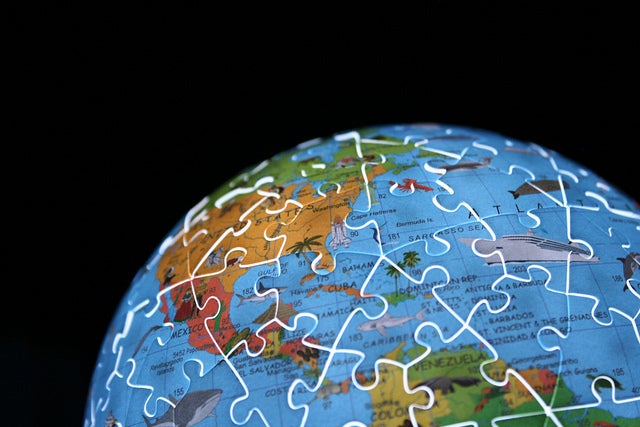
Globe
On the first day of my first year teaching Advanced Placement Human Geography, I naturally started with a map.
I put up a transparency on the overhead projector. It was September of 2001. Smartboards, like African-American presidents and women presidential candidates, were many years away.
The most famous map in the country at the time was the electoral map from the previous November. It displayed red and blue jurisdictions not at the crude level of states, with Florida jutting out like a big “screw you” to democracy, but rather at the finer, more fascinating level of counties.
I asked my students to tell me what they saw.
I asked them to consider how counties related to states. I had them inspect the tiny counties of the east coast. Many of them were designed so that county seats were a day’s mule ride from any point in the county. Their crooked lines follow organic contours of rivers, hills, and human imprecision. I had my students marvel at the mega-counties of the West, with straight lines driving through uninhabited desert and over indifferent mountain ranges.
I told them to look at the red and at the blue. Who were those people? What were those places like? Why did they vote for whomever they voted for? Were they like us? Were they different? How red were they? How blue were they?
That was the map that inspired “One Nation, Slightly Divisible,” the Atlantic Monthly article that vaulted David Brooks to the big leagues of punditry and made the idea of “Red” and “Blue” America the defining idea of national politics. It included the resounding observation, “everything that red America does with a motor, Blue America does without a motor.” If only that adverb in his headline still applied.
David Brooks had to tell us about Red and Blue America because we did not already know about them. We had been living among each other and yet were unaware of each other, each hiding from the other in plain sight.
And thus, I introduced my students to geography’s fundamental axioms: people are different in different places; there are reasons why they are different; those differences have consequences. The next week – the second week of September 2001 – we found out just how momentous those consequences can be. This November, we found out again.
We learned a lot that year in AP Geography. I know that not because I’m making assumptions about my students but because I’m stating a fact about myself. I learned a lot that year.
Here’s some of what we learned:
Globalization celebrates the efficiencies of comparative advantage
Capitalism, consumerism, and pop culture can obliterate local traditions
Cities buy raw materials from their hinterlands and hinterlands acquire specialty goods and services from cities
Most immigrants move for economic opportunity
Patriotism means love of country; nationalism means thinking your country is better than others
Centripetal and centrifugal forces are always at work in a country
The majority of a developed country’s wealth comes from services, not industry
The geographical advantages of old-style industries have given way in light of communications and transportation technologies
The American dream of suburbia is as much a product of policy as it is of preference
The majority of America’s economic activity takes place in cities
Climate change will wreak havoc and redraw borders
A nation and a state are not the same thing
De jure boundaries can never fully reflect de facto regions
Boundaries can be manipulated for political gain
Our notion of a “country” does not begin to express the relationships, or lack thereof, between ethnicity, religion, languages, sovereignty, and statehood
Healthy ecosystems are economic assets
Racism, ethnic tension, ethnic cleansing, and genocide persist before our very eyes
The world is a very, very complex place
I defy anyone to say that these topics are not fascinating and vital. (I subsequently authored a study guide for the course.)
The subtitle I assigned to my class was “The Global Condition.” I named it so to emphasize the course’s natural focus on current events. Amazingly, my class was the only class at the school that explicitly focused on current events. More amazingly, it’s one of the only courses in all of high school that focuses on current events.
Even the most accomplished American high school student can graduate knowing more about criminal justice in Puritan New England than about the actual injustices going on every day in the United States. Students can learn every step of the process of photosynthesis and yet have never heard of the Kyoto Accords. They can know how nuclear fission works, and yet they don’t know which countries have nuclear weapons and don’t understand the (perverse) logic of mutually assured destruction. They know the Five Pillars of Islam but don’t know what modern-day country Mecca is in.
My school committed an act of bravery in offering AP Geography. Back then, it was a brand-new AP course with scanty enrollment nationwide. AP Geography has gained popularity today, but it’s still a fringe topic, sometimes offered as a throwaway AP to students as young as freshman. I’d wager that my school was the only school in the county in which a majority of seniors took it. Many schools try to fit it and its account of the entire world into a single semester.
In short, the typical high school curriculum renders Americans geographically illiterate. That’s partly because our 3 million square miles of continent mean that we don’t have to care about geography. By contrast, it’s a core subject in many European countries, both in high school at the university level.
Our ignorance about the world and about each other has finally taken its toll, in the unlikely form of Donald Trump. Trump represents the most simplistic answers to the questions that we explored in geography, and he preys on the unfamiliarity – and, indeed, mistrust – that divides Red places from Blue.
I do not claim that AP Geography, or any other course, can cure all that ails America – or that geographic knowledge would have, or should have, dissuaded Americans from voting for him. We should have been learning it to address the very real challenges that concern him and his voters. The study of geography takes seriously the very issues that most vex our nation, regardless of who is president.
Back in 2001, if I mentioned Donald Trump at all, he’d have been in the chapter on urban development. (Why do people build skyscrapers? Usually maximize the use of land that is expensive by virtue of its centrality. Sometimes to inflate one’s ego.) From today onward, he’ll be in every history textbook. They’re probably rewriting them as we speak.
As for that map? It looks much the same today as it did 16 years ago. The colors just run deeper.
